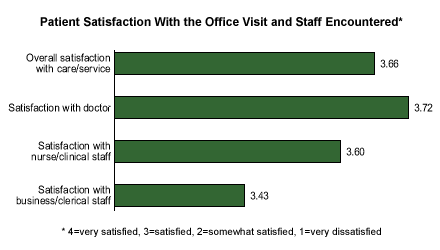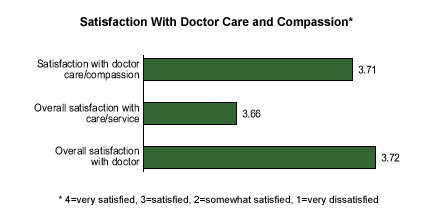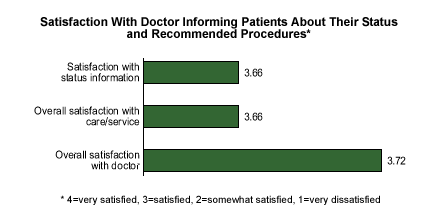What is the key to patient satisfaction with visits to the doctor's office? Simple: it goes no further than satisfaction with the doctor him or herself. That may not come as a surprise, but it is important that while other attributes -- such as convenience of office hours or the atmosphere of the office -- are important, in the patient's mind they are largely irrelevant to overall satisfaction.
How Satisfied Are Patients With Their Doctor During an Office Visit?
Findings from Gallup's aggregated healthcare-industry database indicate that for the most part, patients are very satisfied with their doctors during office visits. Not only do patients tend to be more satisfied with their doctors than with other office staff, they are also more satisfied with their doctor's performance specifically than with the overall office experience.

But physicians should avoid becoming complacent about satisfaction levels. The doctor plays such an important role in the treatment process that minor flaws in the way he or she interacts with patients, if consistent, can produce widespread dissatisfaction. While conducting a study of physician malpractice suits, Dr. Gerald B. Hickson, vice chair of pediatrics at Vanderbilt University, found that in his own practice, 9% of the doctors account for 50% of unsolicited complaints.
Where Should Doctors Focus?
As reported in the American Medical News, Hickson concluded that in order to keep their patients satisfied, physicians must pay equal attention to the technical and non-technical aspects of patient care. Two "non-technical" aspects of patient care that are measured in Gallup's physician office patient database emerge as critical to patient satisfaction.
1. Doctors' care and compassion
While Gallup data show that satisfaction with doctors' care and compassion is high, there is certainly room for improvement.

Showing care and compassion goes beyond being nice. Certain keys to success are obvious and well documented:
- Knock before entering the treatment room.
- Walk all the way into the room and sit while talking to the patient.
- Introduce yourself.
- Address the patient by name.
Other ways to show care and compassion are less obvious. A major concern that patients in Gallup focus groups express is that they want to be treated as people, not as diagnoses. What better criteria for "care and compassion" could patients give to physicians?
What causes a patient to feel like a diagnosis instead of a person? When the doctor does not give the patient or patient's family an opportunity to talk or ask questions. From the patient's perspective, a doctor cannot correctly diagnose and treat a problem if he or she does not listen to the patient's concerns. The end of a patient encounter is a critical period. The physician must ensure that the patient and family have asked all the questions they wish to ask, and feel comfortable with their understanding of the visit and any follow-up instructions.
2. The effectiveness with which doctors keep their patients informed about their status and recommended procedures
While still fairly high, patient satisfaction with doctors' communication is not as strong as satisfaction with their care and compassion.

Patients go to physicians' offices first and foremost to obtain information about their health. While in the office, patients want to understand what is happening and what the doctor will do for them in the future. Physicians must be experts in communication.
Many patient questions are predictable. The doctor should anticipate these questions, have a strategy for answering them, and provide the answer before the patient even asks the question. For example, mothers bringing in their children for immunizations may ask questions like, "Why do we need this immunization when no one gets these diseases anymore?" or "Isn't the risk of side effects greater than the risk of the disease?" Anticipating questions reinforces a physician's credibility and increases the likelihood the patient will leave feeling satisfied.
Key Points
No matter how successful the physician, he or she may achieve improvement and continued success in patient relations by focusing on a few basics:
- Give patients an opportunity to talk and listen to what they have to say.
- Treat patients as people, not as medical conditions.
- Anticipate patient questions and provide answers before they ask.
- Explain what you are going to do, what you are doing, and why you did it.